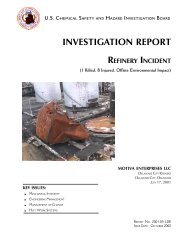CTA Report, Draft 1, ISP Review - US Chemical Safety and Hazard ...
CTA Report, Draft 1, ISP Review - US Chemical Safety and Hazard ...
CTA Report, Draft 1, ISP Review - US Chemical Safety and Hazard ...
Create successful ePaper yourself
Turn your PDF publications into a flip-book with our unique Google optimized e-Paper software.
the possibility of an explosion or fire damaging other portions of the plant. To control dust accumulation,<br />
this version of the st<strong>and</strong>ard recommended that:<br />
• Horizontal surfaces be minimized by having their tops sharply inclined, or by “boxing” in<br />
steel I-beams or similar structural shapes.<br />
• Buildings be equipped with explosion venting.<br />
Combustible dust-h<strong>and</strong>ling operations at the Corbin facility were not detached. Two-hour-rated masonry<br />
block firewalls—not physical barriers designed to withst<strong>and</strong> fire <strong>and</strong> explosion hazards—partially<br />
segregated these operations from surrounding storage <strong>and</strong> maintenance areas. In addition, the facility did<br />
not minimize horizontal surfaces, I-beams <strong>and</strong> open web roof trusses were not boxed, <strong>and</strong> no explosion<br />
venting was provided.<br />
<strong>CTA</strong> did not follow the more recent editions of NFPA 654 when modifications were made to the blend<br />
rooms (1992) or when firewalls were removed separating the production area from the finished goods<br />
area (2002). At the time of the incident, the building contained numerous elevated, hard-to-clean<br />
horizontal flat surfaces—such as tops of process pipes, sprinkler pipes, electrical conduits, <strong>and</strong> cable<br />
trays. These surfaces allowed the accumulation of substantial combustible dust, which provided fuel for<br />
the fire <strong>and</strong> explosions. Minimization of flat surfaces likely would have prevented accumulation of<br />
combustible dust <strong>and</strong> eliminated it as a source of fuel for the fire <strong>and</strong> explosions.<br />
Lack of effective firewalls at <strong>CTA</strong> allowed the fire to spread beyond line 405. Proper placement of<br />
firewalls around the production area could have prevented the spread of the fire to the raw material<br />
storage <strong>and</strong> maintenance areas. Some existing firewalls were knocked down in the explosions. Use of<br />
blast-resistant physical barriers designed to withst<strong>and</strong> deflagration <strong>and</strong> use of deflagration venting to a<br />
safe outside location could have minimized the spread of explosive forces (Appendix D.2.3).<br />
72









